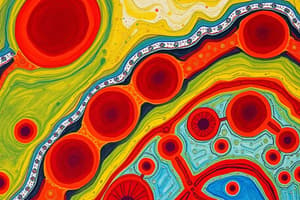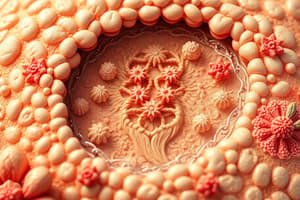Podcast
Questions and Answers
Which type of cell is most abundant in the epidermis?
Which type of cell is most abundant in the epidermis?
- Tactile epithelial cells
- Melanocytes
- Dendritic cells
- Keratinocytes (correct)
What is the primary function of keratin?
What is the primary function of keratin?
- To provide a tough, protective barrier for the skin (correct)
- To provide a pigment that protects against UV radiation
- To form tight junctions between cells for stability
- To produce antibiotics that destroy pathogens
How are keratinocytes connected to each other?
How are keratinocytes connected to each other?
- Through gap junctions
- By a large number of desmosomes (correct)
- Via specialized protein channels
- By tight junctions
What happens to keratinocytes as they approach the surface of the skin?
What happens to keratinocytes as they approach the surface of the skin?
Approximately how long does it take for the epidermis to be replaced by new cells?
Approximately how long does it take for the epidermis to be replaced by new cells?
Flashcards
Epidermis
Epidermis
The outermost layer of skin; comprised of keratinized stratified squamous epithelium.
Keratinocyte
Keratinocyte
The most abundant cell type in the epidermis, responsible for producing keratin, a tough protein that provides protection.
Desmosomes
Desmosomes
A type of cell connection that holds keratinocytes tightly together, contributing to the skin's strength and integrity.
Keratinocyte Cell Turnover
Keratinocyte Cell Turnover
Signup and view all the flashcards
Callus Formation
Callus Formation
Signup and view all the flashcards
Study Notes
Epidermis Overview
- The epidermis is a keratinized stratified squamous epithelium.
- It contains four main cell types: keratinocytes, melanocytes, tactile epithelial cells, and dendritic cells.
- Keratinocytes are the most abundant cell type.
Keratinocytes
- Produce keratin, a tough protein, providing protective properties.
- Play a vital role in physical and mechanical protection.
- Produce antibiotics and enzymes to detoxify harmful chemicals.
- Tightly connected by numerous desmosomes.
- Originate in the deepest epidermis through continuous mitosis.
- As they move upwards, fill with keratin.
- By the surface, they are dead, flat keratin sacs.
- Millions of dead cells slough off daily, renewing the epidermis every 35-45 days.
- Increased cell production and keratin formation in areas of high friction.
Studying That Suits You
Use AI to generate personalized quizzes and flashcards to suit your learning preferences.




